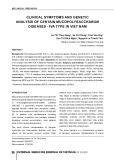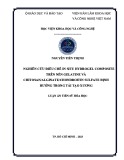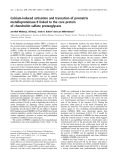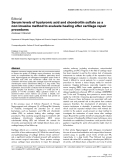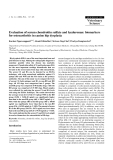
INTERNAL MEDECINE JOURNAL OF VIETNAM|NO 22/2021
56
CLINICAL RESEARCH
CLINICAL SYMPTOMS AND GENETIC
ANALYSIS OF CERTAIN MUCOPOLYSACCHARIDE
DISEASES - IVA TYPE IN VIET NAM
Le Thi Thuy Hang1, Vu Chi Dung2, Tran Van Duy1
Can Thi Bich Ngoc2, Nguyen Le Thanh Thu1
1Military Hospital 103, Military Medical University
2Central Children's Hospital
ABSTRACT
Background: Mucopolysaccharide IVA is a rare recessive genetic disease resulting from a deficiency of
N 6 sulfatase acetylgalactosamine (galactose 6 sulfatase) - a lysosome’s enzyme necessary to degrade
keratan sulfate and chondroitin sulfate. Objectives: To describe clinical characteristics and genetic analysis
of 13 children with MPS IVA in National Pediatric Hospital. Subjects and methods: 13 patients with MPS
IVA were diagnosed based on analysis of clinical data and enzyme activity. Five were analyzed for the gene.
Results: ligament manifestation accounted for 100%, sternal deformation - 92.3%, dwarf - 61.5%, hearing loss
- 58.3%, mild mental retardation - 38.5%, heart valve lesions, cornea opaque - 30.8%, rough face - 15.4%,
hepatomegaly - 7.7%. 5 mutations were detected: p.V427SfsX14, p.P125L, p.Y385X, p.A291T, c.899-2A> C.
Conclusion: Ligament laxity and bone deformity, especially sternal deformation, are highly valuable for
diagnosing MPS type IVA. The discovery of genotypes will help doctors in giving genetic advice to families.
* Keywords: Mucopolysaccharide (MPS); Glycosaminoglycans (GAGs).
INTRODUCTION
Mucopolysaccharide IVA (MPS IVA) is an autosomal
recessive genetic disease resulting from a deficiency
of N-acetylgalactosamine-6-sulfate sulfatase
(GALNS) - a lysosome’s enzyme necessary to
degrade keratan sulfate and chondroitin sulfate.
The live birth incidence of MPS IVA is 0.15/100,000
[1]. In patients with manifestations including
short stature, capitellum, and cartilage (skeletal)
dysplasia, corneal accumulation, most patients
have normal mental development.
The main clinical manifestations of Morquio
syndrome are bone-related features and their
effects on the central nervous system. Most
patients have a regular appearance at birth. Then
they begin to develop symptoms including venu
valgum, kyphosis/gibbus, growth retardation, short
stature, short neck, abnormal gait, easy to stumble,
etc. that are early symptoms of Morquio syndrome.
Typical skeletal abnormalities of Morquio syndrome
include short stature, dwarf, vertebra plana,
odontoid hypoplasia, spinal abnormalities, cervical
instability, vertebra ovarian deformity, pectus
deformity, venu valgum, deformed ulna, elbow
deformity, deformed metacarpus, short phalanges,
capitulum deformity, osteoporosis.
The loose ligament is a characteristic symptom
of Moriquio syndrome. Manifestations of spinal
Corresponding author: Le Thi Thuy Hang
Date received: 28/4/2021
Date accepted: 27/5/2021





